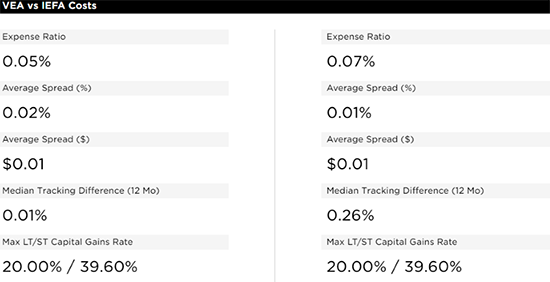International Equities Positioned To Win

When constructing the equity portion of their portfolios, U.S. investors are often advised to have both domestic and international equities within their portfolio.
In thinking about the investment set available, consider a global ETF like the iShares MSCI ACWI ETF (ACWI). This fund allocates 61% to U.S. equities while 39% is held across international developed and emerging market equities.
Due to a phenomenon known as home-country bias, U.S. investors often have their own equity allocations tilted more toward domestic equities than international equities. And for the most part, this bias has been to the benefit of their portfolios.
Of the past 13 years, the SPDR S&P 500 ETF Trust (SPY) has bested the performance of the iShares MSCI ACWI ex U.S. ETF (ACWX) for 10 of them. In other words, the more domestic equity within an investor’s portfolio, the better the portfolio has done.
2009 | 26.35% | 35.47% |
2010 | 15.06% | 10.39% |
2011 | 1.89% | -14.01% |
2012 | 15.99% | 17.05% |
2013 | 32.31% | 14.79% |
2014 | 13.46% | -5.04% |
2015 | 1.23% | -5.80% |
2016 | 12.00% | 4.54% |
2017 | 21.71% | 27.20% |
2018 | -4.57% | -13.95% |
2019 | 31.22% | 20.85% |
2020 | 18.33% | 10.29% |
2021 | 28.73% | 7.67% |
This lopsided performance has been to the detriment of diversified portfolios, and perhaps even convinced some investors that allocating to international equities is not necessary. But could 2022 see international equities outperform U.S. markets?
Some data suggests this could be the case. Analysts at Goldman Sachs are predicting the eurozone economy will grow at a rate of 4.4% this year versus just 3.5% for the U.S. They also see the eurozone outpacing U.S. growth in 2023 as well.
Part of the rationale for their view is that European fiscal policy is likely to remain accommodative this year, while the Federal Reserve has made clear it will need to act more aggressively than previously predicted to control inflation.
The Fed’s need to take action is underscored by the most recent CPI reading, showing that inflation has risen at a pace of 7% over the past year, the highest reading since 1982.
International Exposure Options
For those who want broad exposure to international markets, two ETFs stand above the rest in terms of assets. The Vanguard FTSE Developed Markets ETF (VEA) is the largest, with $110.3 billion in assets under management. The iShares Core MSCI EAFE ETF (IEFA), which is benchmarked to an MSCI index instead of one managed by FTSE Russell, has gathered $104.34 billion.
Though both funds have single-digit expense ratios, VEA has the very slight advantage, which comes down to just 0.01% when spread is taken into account.
Courtesy of FactSet
(For a larger view, click on the image above)
However, VEA has a much smaller median tracking difference relative to IEFA.
But the biggest difference between the two funds comes down to the countries to which they offer exposure. The FTSE index tracked by VEA considers South Korea to be a developed market, making up nearly 5% of the fund.
Courtesy of FactSet
(For a larger view, click on the image above)
The MSCI index tracked by IEFA does not include South Korea, as MSCI classifies the country as an emerging market.
Courtesy of FactSet
(For a larger view, click on the image above)
Canada is also not included within IEFA, as the fund excludes North America, whereas it’s the third largest country exposure within VEA.
In spite of these small differences, the funds are nearly indistinguishable from one another in terms of performance since IEFA’s launch in October 2012.

Emerging Markets Included
For those who want their international exposure to include emerging markets, ETFs like the iShares Core MSCI Total International Stock ETF (IXUS) and the Vanguard FTSE All-World ex-US ETF (VEU) include both developed and emerging market exposure.
IXUS currently has about 12.5% of its portfolio within emerging market stocks, while VEU is slightly higher, at 13.1%.
Knowing whether your international equity ETF has emerging market exposure is important when considering the rest of your portfolio. If an investor purchases an emerging market ETF such as the Vanguard FTSE Emerging Markets ETF (VWO) in addition to an international fund like IXUS or VEU, they could potentially have greater exposure to this asset class than desired.
This is especially risky given the potential volatility within emerging market equities. Looking back at 2021, emerging markets underperformed both domestic and international developed markets.

VWO was barely positive for the year, returning just 1.26%. This means VEU’s allocation to emerging markets was a negative contributor, causing it to underperform the developed-only VEA.
Importance Of Diversification
Regardless of which ETF is chosen, investors should give thought to the international equity allocation within their portfolios. One argument for diversification is that the future is uncertain—yesterday’s winner won’t necessarily be on top tomorrow.
And while international markets have lagged domestic equities for much of the recent past, this has led to international equities looking relatively cheap in terms of valuations. Combined with the coming shifts in monetary policy, it is possible that 2022 will be the year for international equities to rise again.
Contact Jessica Ferringer at jessica.ferringer@etf.com and follow her on Twitter
Recommended Stories



